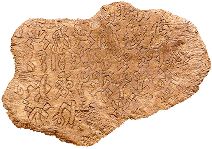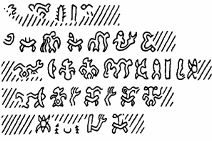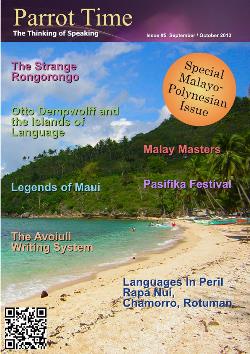
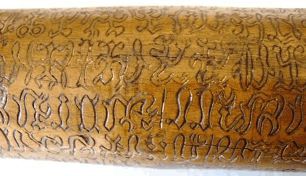 Closeup of the Rongorongo staff Cataloguing Perhaps the person most involved in cataloguing and understanding the Rongorongo tablets in the last century was Thomas Barthel. He visited most of the museums which had tablets and made pencil rubbings of them. From this data, he compiled the first collection of the script, and he published this as Grundlagen zur Entzifferung der Osterinselschrift (Basics of Deciphering the Easter Island Writing) in 1958. He was also the first scholar to correctly identify anything in the texts. Barthel gave each script a single capital letter and a name, like "Tablet G: the Little Tablet of Santiago". There is no real standard in the names, with some being descriptive while others refer to where they are. Other names include "Crescent Tablet", "Snuffbox", "Oar", "Crescent [piece of] Wood", "Santiago Staff", "Worm-eaten Tablet" and "Great Tablet". There are 26 such tablets that are believed to be authentic, and not created later by others. He also distinguished the two faces of a tablet with a suffix of r (recto - "front") or v (verso - "back"). This differs in a few cases for objects that don't have exactly 2 sides, such as the Santiago Staff, which is a single round item, and the Snuff Box, which has six sides. Each of the texts has between 2 and 2320 glyphs, with some of them compounded, for a total over 15 thousand. Barthel assigned a numerical three-digit code to each glyph or group of similar glyphs which he believed to be allographs (variants of other glyphs). This produced 600 numeric codes. These codes were not simply assigned as the numbers one through six hundred. Each of the three digits represented a certain aspect. For example, the hundreds place (leftmost digit) is a numeral from 0 to 7, and refers to the head or, if there is no head, the overall form of the glyph: 0 and 1 for shapes and inanimate objects, 2 for characters with ears, 3 and 4 for those with open mouths with legs or tails, 5 for other heads that don't fit the previous groups, 6 for ones with beaks, 7 for non-humans, like fish. The other two digits have similar roles, referring to various common patterns, like the positions of arms or wings. While the assignment of the numbers to different aspects might not be perfect, it remains the only effective system yet proposed to catalogue the glyphs.
Translating A few people have made attempts at translating the script, but nothing conclusive has been proven. In Tahiti, Jaussen had found a laborer from Easter Island, Metoro, who claimed to be able to read the tablets. Metoro would take a tablet, rotate it to find it's beginning, then start chanting what is written. Jaussen made charts of the characters, grouping them by similarity and what he thought they might mean. He based his meanings on what Metoro told him each glyph meant. Metoro also gave him a complete translation of one of the tablets. From this, he was able to produce a translation for others, but the results were so senseless that he even wrote in an introduction to it that "One must resign, there is no sense in it". There are a few barriers to providing an accurate translation, even if Rongorongo is a true writing system. Later study of the translations would provide a reason as to why Jaussen's translation made no sense. Jaussen had collected the items and the information, but had never truly analyzed what he had. While Metoro had given him a translation of a tablet, Jaussen had not compared that with the meanings of the symbols. They did not match. William J. Thomson was the paymaster on the USS Mohican. He spent twelve days on Easter Island in December,1886, and during that time he found a man named Ure Va'e Iko who claimed to understand the texts. He had been the steward of King Nga'ara, the last king who was said to have had knowledge of writing. While Va'e Iko could not himself write, he knew many of the chants. Thomson gave him money and gifts to get him to read photographs of Jaussen's tablets. At first, Thomson believed Va'e Iko, but then he began to notice that he would recite the same translation for completely different photographs. Va'e Iko would also often turn the photograph before reading out the same number of glyphs as on the line. It is unclear as to why Va'e Iko was misleading Thomson, but part of the reason may have been that the scripts were considered sacred and thus not to be shared with outsiders. It was apparent, though, that this was not going to produce a true translation. 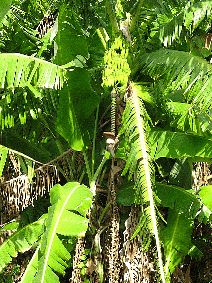 A banana tree, like those that the tangata rongorongo would sit under as they taught others how to create the Rongorongo texts Katherine Routledge, a British archaeologist and anthropologist, conducted a scientific expedition to Rapa Nui with her husband in 1914. The intent was to catalogue the art, customs, and writings of the island. When they arrived, she interviewed two elderly natives, Kapiera and Tomenika, who were said to have some knowledge of the tablets. However, their explanations often contradicted each other. Kapiera told Routledge that each character had both a literal meaning, like the object it represented, and a sort of "reminding" meaning, referring to something in the mind of the reader. Those meanings would probably have then been passed down orally. That would be similar to someone tying a knot in a string to remind them of something; the knot represents what they should remember, but any other person would see it simply as a knot. Routledge concluded that Rongorongo did not directly represent language, but rather was an idiosyncratic mnemonic device or proto-writing (systems that have many characteristics similar to writing). She figured that the meanings of the characters were redefined by each scribe of a text, so that the text could only then be read by someone with specific knowledge of that text. There are a few barriers to providing an accurate translation, even if Rongorongo is a true writing system. There are so few remaining texts that making any valid pattern matching impossible. There are no illustrations or other means to guess the context of the text. If Rongorongo was related to the old Rapa Nui language, that has since become so mixed with Tahitian that it would likely not match the written text anymore. 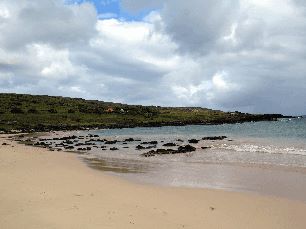 Some of the Rongorongo texts were carved into wood that would wash up on the beach Many other translation attempts have been made, most being largely unlikely. Australian pediatrician Alan Carroll published a translation in 1892 that was based on an idea of the texts being written by an extinct "Long-Ear" population of Easter Island and represent some mixture of Quechua and other languages of Peru and Mesoamerica. However, he did not publish any methods of analysis or meaning for the glyphs to prove the translation. Hungarian Vilmos Hevesy published an article in 1932, claiming that Rongorongo and the Indus Valley script were related because they had some similarities. However, since both scripts are undeciphered, were found on different sides of the world (the Indus Valley being in the region of Afghanistan), and have their origins an estimated 4000 years apart, this connection is very unlikely. 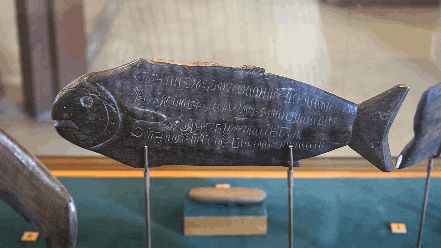 Rongorongo tablet shaped like fish Independent linguist Steven Fischer announced in 1995 that he had "cracked the Rongorongo code". He noted that the text of the Santiago Staff was different from the others, in that it had "punctuation" in the form of vertical lines in many place. He also interpreted a particular glyph as a phallic symbol, which he translated as "copulated". This results in his translation containing several references to animals and objects copulating with each other, such as "fish copulated with the sun", which many scholars have disregarded as just silly. Fischer also claims to have deciphered the Phaistos Disc, but that too is disregarded as valid because, in both cases, too many assumptions are made that only relate to a small volume of the known text. Conclusion From what was learned from the natives of Easter Island as well as linguistic analysis, the Rongorongo script is most likely not a true writing system or language. If so, then the meaning and purpose of the texts and the objects they were written on will never be discovered. We can be sure, however, that people will continue to have their own ideas on what they mean. | ||||
| Rongorongo - Island Chants | ||||||||||||
| Writer: | Lucille Martin | |||||||||||
| Images: | ||||||||||||
| ||||||||||||
| Sources: | ||||||||||||
| ||||||||||||
All images are Copyright - CC BY-SA (Creative Commons Share Alike) by their respective owners, except for Petey, which is Public Domain (PD) or unless otherwise noted.
comments powered by Disqus
